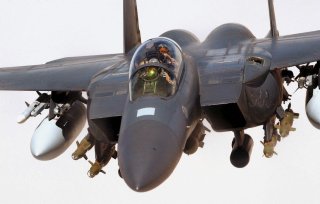Bomb Truck: Why the Air Force Loves the F-15EX
According to The Aviationist, which cited a U.S. Air Force photo, the Strike Eagle was seen carrying six JDAMs on a single side of the aircraft, back in late February.
Here's What You Need to Remember: “Currently the F-15E is authorized to carry a max of nine JDAMs, but the success of this test expands that to 15 JDAMs,” said Maj. Andrew Swanson, F-15E Weapons System Officer, 85th TES, on the official site of the 53d Wing.
The F-15E Strike Eagle, first made by McDonnell Douglas and now by Boeing, has been around since the 1980s, and has been deployed in conflicts such as Afghanistan, Iraq, Syria and Libya.
Now, the Strike Eagle has debuted a new configuration.
According to The Aviationist, which cited a U.S. Air Force photo, the Strike Eagle was seen carrying six JDAMs on a single side of the aircraft, back in late February.
That confirmation, per the report, “would allow fully assembled JDAMs [Joint Direct Attack Munition] to be transported at a remote location to rearm the F-15E and other aircraft as part of the Agile Combat Employment model.”
This would allow the Strike Eagle to be used as a “Bomb Truck.” The test took place at Eglin Air Force Base in Florida.
According to Stars and Stripes, the recent U.S. air strike on Iran-backed militia groups in Syria utilized a pair of F-15E Strike Eagle fighter jets.
“Currently the F-15E is authorized to carry a max of nine JDAMs, but the success of this test expands that to 15 JDAMs,” said Maj. Andrew Swanson, F-15E Weapons System Officer, 85th TES, on the official site of the 53d Wing.
“While not all the JDAMs carried can be employed in a single mission, this proves the Strike Eagle’s ability to ferry JDAMs while simultaneously releasing them on an active combat mission—a key component to the ACE model,” the 53d Wing report said. “The combat tactic of reloading in a remote location previously took two C-130s to carry the necessary munitions and personnel. Once at the location, the JDAMs had to be assembled, taking extra time. The additional carriage on the F-15E allows fully assembled JDAMs to be transported, reducing the requirement to just one C-130 and saving eliminating onsite bomb building.”
A little over a year ago, Maj. Gen. Brian M. Killough wrote for The National Interest about the future of the Air Force, including the Agile Combat Employment concept of which the planned new configuration is a part.
“Recognizing the need to maneuver air forces and deny completion of an adversary’s kill chain has directly led to the development of the operating concept of Agile Combat Employment (ACE),” Maj. Gen. Killough wrote.
“ACE focuses on the ability to disperse, recover and rapidly resume operations in a contested or austere environment. It is a modern, cross-Major Command (MAJCOM) effort facilitating a shift away from the hyper-efficient, specialized operations of recent decades towards the redundancy, resiliency, decentralized control and decentralized execution required to enable an effective campaign against a near-peer adversary.”
Stephen Silver, a technology writer for The National Interest, is a journalist, essayist and film critic, who is also a contributor to The Philadelphia Inquirer, Philly Voice, Philadelphia Weekly, the Jewish Telegraphic Agency, Living Life Fearless, Backstage magazine, Broad Street Review and Splice Today. The co-founder of the Philadelphia Film Critics Circle, Stephen lives in suburban Philadelphia with his wife and two sons. Follow him on Twitter at @StephenSilver. This article is being republished due to reader interest.
Image: Wikimedia Commons.

